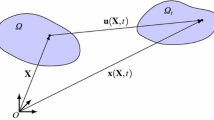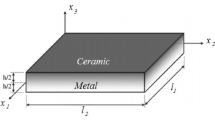Abstract
The work reported herein is concerned with an investigation of the potential of mating time-average holography and static-finite-element analysis (a ‘hybrid’ stress-analysis technique) in solving dynamic problems. The model studied is a vibrating thin rectangular cantilever plate. Realtime holography was used to locate natural vibrating modes of the plate. Experimental data were smoothed to remove scatter using a spline-like procedure in one or two dimensions, as applicable. Two methods of smoothing the experimental displacement data used in the hybrid procedure were considered. The first involved preprocessing (smoothing) the data before they were incorporated into the numerical model, while the second involved smoothing the data as part of the solution process. In both instances the amount of smoothing was specified by the user. The first and fourth vibrational modes were investigated. The results were compared to a NASTRAN dynamic solution and to a Ritz method series solution with very good results.
Similar content being viewed by others
References
Rao, G.V., “Experimental-Numerical Hybrid Techniques for Body-Force and Thermal Stress Problems-Applications in Power Industry,” Proc. 1982 SESA and JSME Joint Conference on Experimental Mechanics, SESA, 398–404 (1982).
Barishpolsky, B.M., “A Combined Numerical and Experimental Method for the Solution of Generalized Elasticity Problems,”Experimental Mechanics,20 (10),345–349 (Oct. 1980).
Macbain, J.C., “Displacement and Strain of Vibrating Structures Using Time-Average Holography,”Experimental Mechanics,18 (10),361–372 (Oct. 1978).
Kobayashi, A.S., “Hybrid Experimental-Numerical Stress Analysis”Experimental Mechanics,23 (3),338–347 (Sept. 1983).
Reinsch, C.H., “Smoothing by Spline Functions”Numerische Mathematik,10,169–175 (1967).
Engelstad, S.P., “Hybrid Stress Analysis Using the Finite Element Method and Holographic Interferometry Data,”Masters Thesis, Dept. of Mech. Eng., Auburn Univ., Auburn, AL (July 1983).
Bell, K., “A Refined Triangular Plate Bending Finite Element,”Int. J. Numerical Methods in Eng.,1,101–122 (1969).
Young, D., “Vibration of Rectangular Plates by the Ritz Method,” Proc. ASME Annual Conf. of the Appl. Mech. Div. (June 1950).
Segalman, D.J., Woyak, D.B., Rowlands, R.E., “Smooth-spline-like Finite-element Differentiation of Full-field Experimental Data over Arbitrary Geometry,”Experimental Mechanics,19(12),429–437 (Dec. 1979).
Author information
Authors and Affiliations
Rights and permissions
About this article
Cite this article
Engelstad, M.J., Chambless, D.A., Swinson, W.F. et al. Hybrid stress analysis of vibrating plates using holographic interferometry and finite elements. Experimental Mechanics 27, 23–30 (1987). https://doi.org/10.1007/BF02318859
Received:
Accepted:
Issue Date:
DOI: https://doi.org/10.1007/BF02318859




